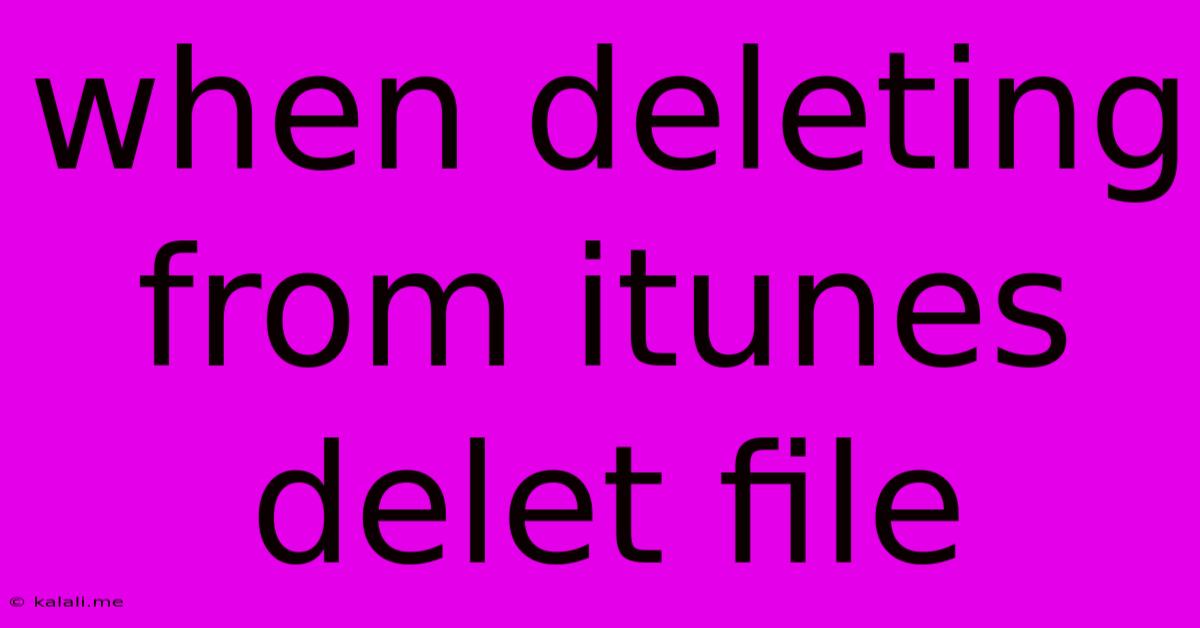When Deleting From Itunes Delet File
Kalali
May 19, 2025 · 3 min read

Table of Contents
When Deleting from iTunes, Does it Delete the File? Understanding iTunes Library Management
This article clarifies the often-confusing behavior of deleting items from your iTunes library. The short answer is: it depends. Deleting a song from your iTunes library doesn't automatically delete the file from your hard drive unless you specifically choose that option. Let's break down the different scenarios and how to manage your music files effectively.
Understanding iTunes' Library vs. Your File System
iTunes maintains a library—a database—that tracks your music files. This library contains information about your songs: artist, album, genre, artwork, and the location of the actual audio files on your computer. Deleting an item from the iTunes library only removes the entry from this database; the music file itself remains untouched on your hard drive until you explicitly remove it.
Methods of Deleting from iTunes and Their Consequences
There are several ways to delete items from your iTunes library, each with different effects:
-
Deleting from the Library: Right-clicking a song or album and selecting "Delete" from the context menu removes it from your iTunes library. However, the files remain on your hard drive. You can find them by navigating to the file system location previously associated with your music files.
-
Deleting from the Library and Deleting Files: Some versions of iTunes offered a 'Delete' option that also removed the associated files from your hard drive. If you see this option, exercise caution. It permanently deletes the files.
-
Consolidating Your iTunes Library: This feature moves all your media files into a single, organized folder. While not directly deleting anything, it can help manage your storage and create a more organized music collection. Be aware of the time it might take, especially with large music libraries. This can be useful before deleting to locate where the music files are kept.
-
Using "Delete Download" option (for Purchased Content): This option is specific to purchased content from the iTunes Store (now Apple Music). Choosing this removes the song from your library and deletes the downloaded file; however, you can still access it through your purchase history to redownload it later.
Finding and Deleting Files Manually
If you want to completely remove a song and its file, you need to do so manually. First, identify where your iTunes library stores music files. The default location can vary slightly between operating systems and iTunes versions, but it's often easily locatable by searching on your hard drive for your music library. After locating the folder, you can manually delete the files. Be absolutely certain before doing this; you cannot recover deleted files easily unless you have a backup.
Best Practices for iTunes Library Management
- Regularly back up your iTunes library: This protects you from accidental data loss.
- Understand the different delete options: Before clicking anything, make sure you understand the consequences.
- Organize your music regularly: This prevents your library from becoming unwieldy.
- Consider using a dedicated media management tool: Alternative applications offer more granular control over music libraries.
In conclusion, deleting from iTunes' interface doesn't necessarily mean deleting the actual file. The effect depends on the specific method used. Understanding these differences is vital for managing your music collection effectively and avoiding accidental data loss. Always back up your valuable data!
Latest Posts
Latest Posts
-
Can You Start A Sentence With You
May 19, 2025
-
Meaning Of Wax On Wax Off
May 19, 2025
-
Man In The High Castle Map
May 19, 2025
-
Why Does My Steering Wheel Shake At High Speeds
May 19, 2025
-
How To Dial To Italy From Uk
May 19, 2025
Related Post
Thank you for visiting our website which covers about When Deleting From Itunes Delet File . We hope the information provided has been useful to you. Feel free to contact us if you have any questions or need further assistance. See you next time and don't miss to bookmark.